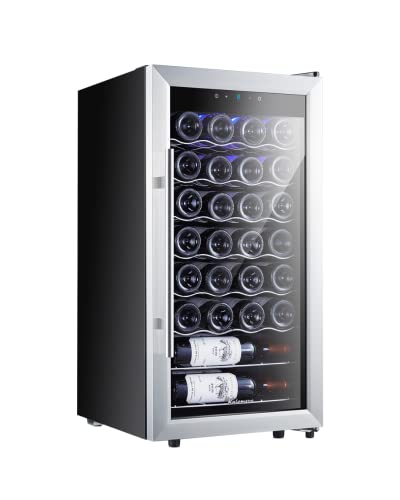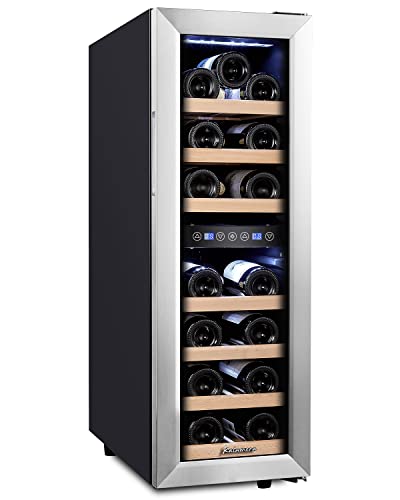Guide To Wine Cooler And Fridge: The Intermediate Guide For Wine Coole…
 How a Wine Cooler and Fridge Can Help Preserve Your Cabernet Sauvignon and White Zinfandel
How a Wine Cooler and Fridge Can Help Preserve Your Cabernet Sauvignon and White ZinfandelKeep your Cabernet Sauvignon and White Zinfandel at their optimal serving temperatures by using wine refrigerators. Some, like the KitchenAid(r) Undercounter wine refrigerator large Cellar also regulate the humidity levels to protect labels and wine from mould.
Traditional refrigerators can be harmful to the wine's flavor. This is why designated wine fridges exist.
Temperature The ideal temperature
A wine fridge is an excellent method to keep your collection of wines at a perfect serving temperature. This makes it easier to serve them. To keep the aroma and taste of the wine and slow down the aging, the temperature should be constant and stable. The temperature should be a little lower than room temperature to ensure the wine doesn't get too cold, which can diminish the flavors.
The best wine coolers are made to keep a temperature of 54 and 57 degrees Fahrenheit (11 and 14 Celsius). This is an ideal temperature range for storage that lasts a long time, because it can slow down the aging process and stop the wine from becoming too dry. The temperature should not be too high, since this could cause oxidation or other problems.
You can utilize a single-zone wine fridge to store your entire collection, or you can get a dual-zone wine refrigerator that lets you separate the wine into two different zones for better control of the temperature. You can keep red wines in one area, and whites in the other to serve each wine at the right temperature. This will enhance your drinking experience and make it easier to prepare a cocktail party or dinner, as you can simply shift the bottles into the appropriate zone the night before.
Certain models of wine fridges will have a user manual that contains information on the specific temperature settings. This document is essential to know the temperature control features on your wine cooler. It is also a good idea to check the temperature of your wine refrigerator frequently, as it can fluctuate. Keep the wine refrigerator away from sunlight and heat sources to prevent it from overheating. It is recommended to not open the wine refrigerator too often, as this may cause the temperature to fluctuate.
Humidity Control
Humidity is an important factor in wine storage. Low humidity levels cause corks to dry out, compromising the seal and allowing oxygen to enter the bottle. This alters the taste of the wine and could result in off-flavors. High humidity levels promote the growth of mold and mildew which can affect the labels on wine bottles. A wine cooler that has integrated humidity control can help you achieve optimal conditions for aging your wine collection.
The ideal range of humidity is 50% to the 80% mark. Certain wine refrigerators come with the ability to dehumidify which helps regulate humidity. It helps remove excess moisture. It is crucial to keep in mind that high levels of humidity can impact the quality and legibility on labels for wine. Additionally regular humidity levels can encourage even the aging process of your wine collection and encourage the development of complex flavors with time.
Humidification methods for your wine fridge are simple and simple to implement. The most common is to place small trays filled with water at the bottom of your refrigerator. As time passes the water will evaporate and raise the humidity of your wine rack fridge refrigerator. You could also consider adding a humidifier that is made for small spaces. Many are energy-efficient and offer an adjustable humidity setting.
Another alternative is to make use of baking soda, which is a natural moisture-absorbing properties. You can open a container and put it in the refrigerator to reduce excessive moisture. You can also make use of silica gel bags, which are often used to pack electronic items and food items. Just be certain to replace them regularly.
Some wine fridges have built-in humidity control systems that automatically regulate moisture levels based on pre-set parameters. These systems are more accurate than passive methods, and are particularly useful when you have an extensive wine storage space with different humidity requirements for different types of wine. Finally, professional wine cellars have built-in cooling systems that provide a controlled atmosphere to age your wine collection. These are the best for expensive wines that need an environment that is stable to age.
Noise Reduction
Wine coolers and refrigerators are great investments for those looking to preserve the quality of their wines. While in operation these appliances can generate some noise that could cause disruption or distraction. There are various steps that can be taken to lessen the volume of noise generated by these devices.
One of the major sources of noise from wine refrigerators is compressor cycling. This process involves the circulation of refrigerant in order to cool the fridge's interior and can result in the fridge to groan and make buzzing sounds. It is therefore essential to put the fridge on a flat, level surface to avoid vibrations and noise.
Internal Vibrations
The noises of scraping and rattling that result from bottles rubbing against each other or the shelves is another common source of wine refrigerator noise. This can be reduced by ensuring that the bottles are safely stored and securely packed to limit movement. To minimize noise, it is helpful to make use of wooden shelves or racks instead of metal.
A good ventilation system can lower the volume of noise that is emitted by a wine refrigerator. Regularly cleaning the fridge is essential to get rid of dust and other debris that could be a source of obstruction to with the flow of air. It is also recommended to put an isolation pad made of rubber underneath the fridge. This will help isolate it from the hard flooring and minimise any vibrations that can create noise.
Wine refrigerators typically produce between 35 and 45 decibels during normal operation. This is similar to the background noise heard in a quiet suburban home or library. It is an appliance with an extremely low level of noise.
If your wine fridge is producing louder sounds than usual, it's often beneficial to refer to a manufacturer's troubleshooting guide or contact an expert to come out and fix it. This will tell you if the appliance is working exactly as it should, or the possibility of a more serious problem is present. The technician can identify the problem and repair it if needed.
Versatility
A refrigerator is ideal for keeping drinks chilled however if you intend to store and mature wine in a fridge, it will not be the best environment. Utilizing a wine cooler will ensure that your bottles are at their optimal temperature, safe from damaging vibrations and keeps a high level of humidity to ensure the best storage and flavor.
The temperature of standard refrigerators can fluctuate due to the fact that they are opened multiple times a day. This can harm the wine since it takes a long time for the temperature to return to its ideal storage level. A wine refrigerator, on the other hand, has fewer openings and a lock to reduce temperature fluctuations and exposure to air. In addition, wine refrigerators usually come with a vibration absorption system which helps to prevent damage to your wines caused by compressor vibration.
In addition to the dangers of temperature fluctuations, a wine refrigerator will also block unwanted smells from getting into the wine bottle due to odors from other foods stored in the refrigerator. This can negatively impact the flavor of your wine, and leave a strong odor on the cork that can leak into your wine.
 In addition the wine fridge is able to store both red and white wines and often comes with display shelves specifically designed for holding your bottles upright so that they can display the stunning artwork on their labels. Some wine fridges offer dual zone settings to allow you to chill, store and age wines at their own unique temperature. Whether you're an avid collector or simply enjoy serving wine to your friends, wine fridges are essential for any home. You can find them available in a variety of sizes and styles including freestanding units and built-in models. Find the ideal wine fridge here.
In addition the wine fridge is able to store both red and white wines and often comes with display shelves specifically designed for holding your bottles upright so that they can display the stunning artwork on their labels. Some wine fridges offer dual zone settings to allow you to chill, store and age wines at their own unique temperature. Whether you're an avid collector or simply enjoy serving wine to your friends, wine fridges are essential for any home. You can find them available in a variety of sizes and styles including freestanding units and built-in models. Find the ideal wine fridge here.


